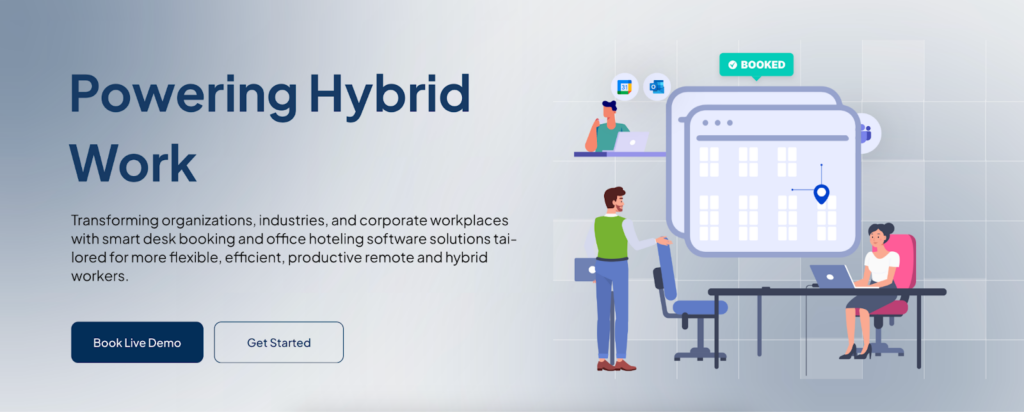An online room booking system helps businesses organize meeting rooms, office spaces, and other resources. It allows users to check availability, make reservations, and manage spaces with ease.
Many companies rely on these systems to avoid double bookings and improve the experience for clients and teams.
In this article, we will talk about what an online room booking system is. We will also explain the steps on how you can maximize the benefits of an online room booking system for your business.
What is an Online Room Booking System?
An online room booking system is a tool businesses use to organize online meeting rooms booking software, office spaces, conference rooms, and desks. It allows users to:
- Check room availability
- Make reservations
- Manage schedules
It often connects with calendars, payment tools, and visitor management systems. This room booking system works for companies that need simple solutions to manage their resources through a single platform.
10 Best Practices to Maximize Your Online Room Booking System
An online room booking system can improve the way businesses manage meeting rooms, desks, and shared spaces.
To achieve the best results, organizations should adopt practical steps that simplify processes, reduce conflicts, and make the system more user-friendly.
1. Update Room Availability Regularly
Accurate room schedules are important for booking appointments. Scheduling software provides regular updates to help users see the real-time status of rooms.
Assigning a team member to monitor and update meeting room availability avoids unnecessary errors.
Businesses can also use automated tools within the system to reflect last-minute changes, such as cancellations or extended meetings. A clear process for maintaining up-to-date information builds trust in the system.
2. Add Detailed Room Descriptions
Clear descriptions of each room provide users with the information they need to choose spaces that meet their needs. You need to list details, such as:
- Room size
- Seating capacity
- Available equipment
- Layout options
This gives users confidence in their selection. Photos or diagrams of the rooms can add clarity, especially for new users or clients.
Providing this level of detail reduces the time spent searching for suitable office spaces. It makes the decision-making process faster and easier for new bookings.
3. Analyze Usage Trends
Tracking usage data reveals patterns that help businesses improve their resource management. Reviewing reports on which rooms are booked most often or at what times identifies high-demand spaces and peak hours.
This allows businesses to adjust booking rules or promote less-used spaces to balance demand. Understanding trends in room usage also highlights opportunities to manage resources efficiently and meet user needs.
4. Offer Training for Team Members
Providing clear instructions helps team members use the system efficiently. A short training session can demonstrate the basic functions, such as:
- Making a booking
- Setting notifications
- Handling conflicts
Written guides or video tutorials can also serve as reference materials for future questions. When users understand how to operate the system, they are more likely to use it correctly and avoid common mistakes.
5. Establish Clear Booking Policies
Creating straightforward rules for reservations, cancellations, and no-shows helps users respect the system and its resources. Clear policies reduce confusion and make the booking process fair for all users.
You can block users who repeatedly miss bookings or charge fees for late cancellations. Automating these policies encourages accountability and compliance in the workplace.
6. Use Mobile Access for Convenience
Allowing users to access the system on their phones or tablets makes the process more convenient. Mobile device compatibility is especially helpful for:
- Remote workers
- Traveling employees
- Clients who need quick access to the system
This flexibility helps businesses meet the needs of various users.
7. Collect and Act on User Feedback
Listening to user feedback provides valuable insights into how the system performs in the work environment. Regular surveys or feedback forms can highlight areas where the system falls short or where users face challenges.
Using this input to improve features or fix issues shows that the organization values user experiences. A feedback loop also builds confidence in the system.
8. Integrate with Other Tools
Connect the booking system with other tools, such as:
- Calendars
- Visitor management platforms
- CRM tools
These integrations eliminate repetitive tasks, such as entering the same information into multiple systems. You can also sync with Google Calendar or microsoft outlook integration to automatically update schedules without manual input. This reduces errors and saves time for everyone involved.
9. Promote Self-Service Options
Allowing users to manage their own bookings through an intuitive platform reduces dependency on support teams.
Clear instructions within the system help users navigate options without needing external assistance. A self-service approach saves time for administrators and improves employee experience software.
10. Test Features Frequently
Checking the system’s features on a regular schedule helps identify potential problems before they disrupt users. You need to test features, such as:
- Notifications
- Conflict alerts
- Mobile functionality
This will have the software working as intended. It also prevents unexpected issues and keeps the system reliable for all users.
Take Control of Your Workspace with DeskFlex
DeskFlex helps businesses manage desks, meeting rooms, and shared resources. Its real-time room scheduling keeps reservations accurate, while room display touchscreens show availability instantly. Workstation touchscreens also make it simple for users to book desks or workspaces directly.
The platform also offers single sign-on to provide secure and fast access and remove the need for multiple logins. It even connects with Microsoft Exchange, Outlook, and Office 365 to sync schedules and manage resources efficiently.
Improve workspace management for your team with DeskFlex. Book a demo today!
FAQs About Online Room Booking Systems
What is an online room booking system?
An online room booking system helps businesses organize reservations for meeting rooms, desks, and shared spaces. It allows users to check availability, make bookings, and manage resources through one platform.
Who benefits from using an online room booking system?
Offices, coworking spaces, event venues, hotels, and any organization that manages shared spaces benefit from these systems. They simplify scheduling and improve how resources are used.
How does an online room booking system avoid double bookings?
The system uses real-time updates and alerts to block overlapping reservations. It notifies users if the requested time slot is unavailable to keep schedules accurate.
Can the system connect with other tools?
Yes, most systems integrate with tools like Google Calendar, Microsoft Outlook, visitor management platforms, and CRM software. These connections make it easier to manage operations from one place.
Does the system work on mobile devices?
Many platforms support mobile access and lets users book or manage reservations through their phones or tablets. This flexibility is helpful for remote teams or professionals who travel often.


